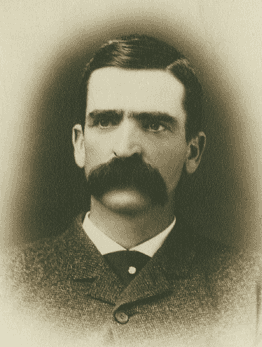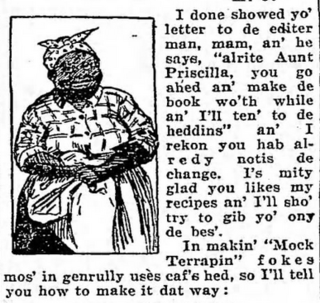
Louise Beavers was an American film and television actress who appeared in dozens of films and two hit television shows from the 1920s to 1960. She played a prominent role in advancing the lives of Black Americans through her work and collaborated with fellow advocates to improve the social standing and media image of the Black population.

Seth Bullock was a Canadian-American frontiersman, business proprietor, politician, sheriff, and U.S. Marshal. He was a prominent citizen in Deadwood, South Dakota, where he lived from 1876 until his death, operating a hardware store and later a large hotel, the Bullock Hotel.

Aunt Bee is a fictional character from the 1960 American television sitcom The Andy Griffith Show played by Frances Bavier. The character migrated to the spinoff Mayberry R.F.D. (1968–1971) when The Andy Griffith Show ended its run in 1968, and remained for two years. Though she was the aunt of Sheriff Andy Taylor, virtually every character in Mayberry, even those in her age bracket such as Floyd and Emmett, called her "Aunt Bee".

Harvey Alexander Logan, also known as Kid Curry, was an American outlaw and gunman who rode with Butch Cassidy and the Sundance Kid's infamous Wild Bunch gang during the late 19th and early 20th centuries. Despite being less well-known than his fellow gang members, he has since been referred to as "the wildest of the Wild Bunch", having reputedly killed at least nine law enforcement officers in five shootings and another two men in other instances. He was involved in numerous shootouts with police and civilians and participated in several bank and train robberies with various gangs during his outlaw days.
Mollie Johnson was a 19th-century madam in Deadwood, South Dakota. Johnson was born in Alabama, and migrated west due to the demand for working prostitutes. Indications are that she began working that trade in her early teens, around the age of 15 or 16 by some reports. However, definite information on her early life is unconfirmed.

The Black Hills is an isolated mountain range rising from the Great Plains of North America in western South Dakota and extending into Wyoming, United States. Black Elk Peak, which rises to 7,242 feet (2,207 m), is the range's highest summit. The name of the range in Lakota is Pahá Sápa. It encompasses the Black Hills National Forest. It formed as a result of an upwarping of ancient rock, after which the removal of the higher portions of the mountain mass by stream erosion produced the present-day topography. The hills are so called because of their dark appearance from a distance, as they are covered in evergreen trees.

Martha Jane Canary, better known as Calamity Jane, was an American frontierswoman, sharpshooter, and storyteller. In addition to many exploits, she was known for being an acquaintance of Wild Bill Hickok. Late in her life, she appeared in Buffalo Bill's Wild West show and at the 1901 Pan-American Exposition. She is said to have exhibited compassion to others, especially to the sick and needy. This facet of her character contrasted with her daredevil ways and helped to make her a noted frontier figure. She was also known for her habit of wearing men's attire.
Charles Badger Clark was an American cowboy poet, and the first poet laureate of South Dakota.
Watson Parker was an American historian, author and academic. Parker, a professor of history at the University of Wisconsin–Oshkosh, specialized in the history of the Black Hills of South Dakota and eastern Wyoming. He was inducted into the South Dakota Hall of Fame in 2011 for his work.

Dewey is an unincorporated community near the southwest corner of Custer County, South Dakota, United States, less than one mile from the Wyoming border in a prairie region of the Black Hills. There are approximately five or six homes in town. Dewey has a volunteer fire department in the Edgemont city district.
Cambria (1889–1928) is a ghost town located in the Black Hills of Weston County, Wyoming, United States. It was a successful coal mining town for decades.
Rochford is an unincorporated community in Pennington County, South Dakota, United States. It is not tracked by the U.S. Census Bureau.
Galena is an unincorporated community in Lawrence County, South Dakota, United States. It is often considered to be a ghost town, although a few families still live in the area. It is not tracked by the U.S. Census Bureau.
Malinda Russell was a free African-American woman from Tennessee who earned her living as a cook and published the first known cookbook by an African-American woman. The book is historically significant, as it shows that African-American Southern cooking was not solely the domain of poverty cooking, but provides evidence of a sophisticated cosmopolitan skill with complex dishes.

Charles A. Randall was an American architect who practiced in Indiana, South Dakota, and Wyoming.

Julia Boyer Reinstein was an American teacher and historian who grew up in western New York and began her career teaching in Deadwood, South Dakota. After more than a decade of teaching, she became a founder of the Erie County Historical Federation and the first historian of Cheektowaga, New York. Committed to preserving the history of the area and educating citizens about their heritage, she and her husband were instrumental in donating properties for the establishment of a nature preserve, several libraries and to higher education. She was a subject of an anthropological study evaluating gender fluidity and the nature of being public about one's sexuality in the 1990s.

Aunt Priscilla was a pseudonym for the columnist Eleanor Purcell of The Baltimore Sun. Purcell used the image of the Mammy archetype to create a cooking column called Aunt Priscilla's Recipes which was purported to be written by an African American woman. The daily column was written in an exaggerated dialect.

Chinatown was a historic ethnic enclave in Deadwood, located in Lawrence County in the U.S. state of South Dakota. It became the largest Chinatown of any city east of San Francisco at the time. Notable figures of Deadwood's Chinatown include Fee Lee Wong, who made his way to the Black Hills during the 1870s for the Gold Rush. There are many cultural and economic differences that made the Chinese community distinct such as success with laundry establishments and the structure of Chinese families. The Chinese community is no longer there like it was at the end of the 19th century. Archeological excavations have tried to document and identify Deadwood's Chinatown artifacts and structures, in order to gain a better idea of what had occurred in these areas. These efforts will help better understand what the lives of Chinese members in South Dakota was like.











